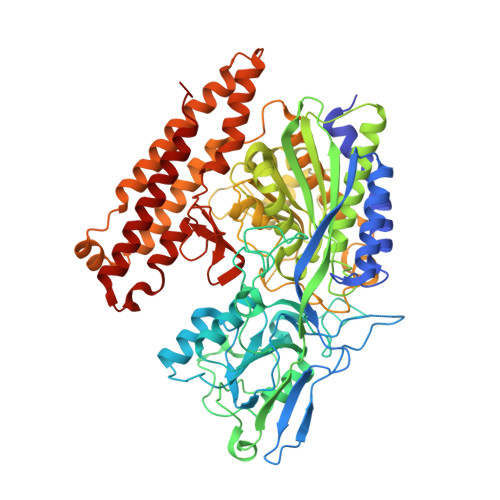Structural insight into the pharmacophore pocket of human glutamate carboxypeptidase II.
Barinka, C., Rovenska, M., Mlcochova, P., Hlouchova, K., Plechanovova, A., Majer, P., Tsukamoto, T., Slusher, B.S., Konvalinka, J., Lubkowski, J.(2007) J Med Chem 50: 3267-3273
- PubMed: 17567119
- DOI: https://doi.org/10.1021/jm070133w
- Primary Citation of Related Structures:
2OR4, 2PVV, 2PVW - PubMed Abstract:
Inhibition of glutamate carboxypeptidase II (GCPII) has been shown to be neuroprotective in multiple preclinical models in which dysregulated glutamatergic transmission is implicated. Herein, we report crystal structures of the human GCPII complexed with three glutamate mimetics/derivatives, 2-(phosphonomethyl)pentanedioic acid (2-PMPA), quisqualic acid (QA), and L-serine O-sulfate (L-SOS), at 1.72, 1.62, and 2.10 A resolution, respectively. Despite the structural differences between the distal parts of the inhibitors, all three compounds share similar binding modes in the pharmacophore (i.e., S1') pocket of GCPII, where they are stabilized by a combination of polar and van der Waals interactions. The structural diversity of the distal parts of the inhibitors leads to rearrangements of the S1' site that are necessary for efficient interactions between the enzyme and an inhibitor. The set of structures presented here, in conjunction with the available biochemical data, illustrates a flexibility of the GCPII pharmacophore pocket and highlights the structural features required for potent GCPII inhibition. These findings could facilitate the rational structure-based drug design of new GCPII inhibitors in the future.
- Center for Cancer Research, National Cancer Institute at Frederick, Frederick, Maryland 21702, USA.
Organizational Affiliation:























